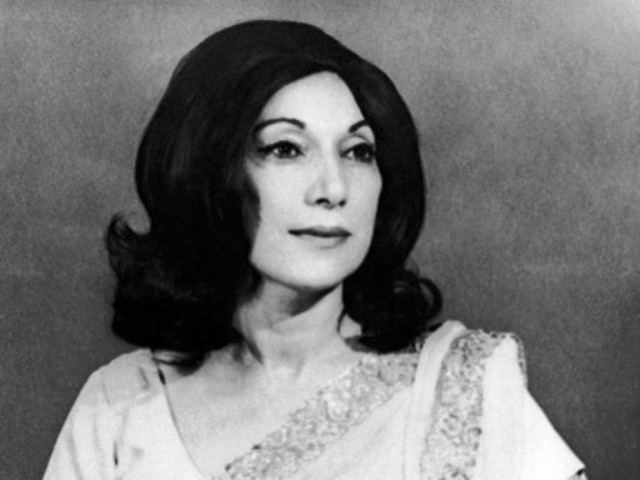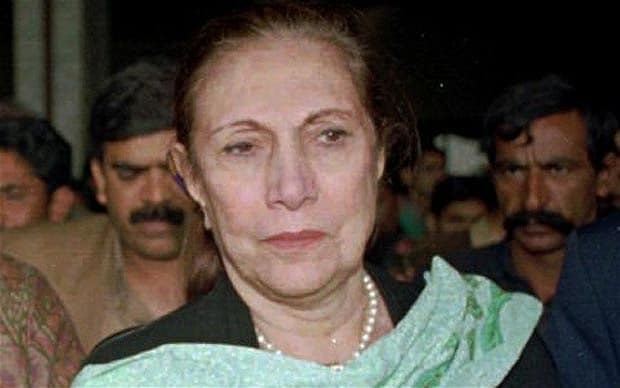Name Nusrat Bhutto | Full Name Nusrat Ispahani | |
 | ||
Succeeded by Shafiq Jahan Zia-ul-Haq Born 23 March 1929Esfahan, Iran ( 1929-03-23 ) Citizenship Iran (1929–1947)Pakistan (1947–2011) Nationality Kurdish-Iranian, Pakistani Political party Pakistan People's Party Spouse Zulfikar Ali Bhutto (m. 1951) Children Benazir Bhutto, Murtaza Bhutto, Sanam Bhutto, Shahnawaz Bhutto Grandchildren Bilawal Bhutto Zardari, Fatima Bhutto Similar People | ||
A stormy Zulfiqar Ali Bhutto and Nusrat Bhutto union
Nusrat Bhutto (Urdu: بیگم نصرت بھٹو, Sindhi: بیگم نصرت ڀٽو; Kurdish: بێگوم نوسرهت بوتو; born Nusrat Ispahani; March 23, 1929 – October 23, 2011) was an Iranian-Kurdish public figure who served as Pakistan's first lady between 1971 until the 1977 coup, and as a senior member of the federal cabinet between 1988 and 1990.
Contents
- A stormy Zulfiqar Ali Bhutto and Nusrat Bhutto union
- Zulfiqar bhutto s wife nusrat bhutto crying while giving the comments on z a flv
- Background
- Family and political career
- Illness and death
- References

Born in Isfahan to an upper-class family of Kurdish descent, the family had settled in Mumbai before moving to Karachi after the Partition of India. Ispahani joined a paramilitary women's force in 1950, but left a year later when she married Zulfikar Ali Bhutto. She moved to Oxfordshire with her husband who than was pursuing his legal education. She returned to Pakistan alongside Bhutto who went on to serve as the Foreign Minister. After her husband founded Pakistan Peoples Party, Ispahani worked to lead party's women’s wing.

After Bhutto was elected as the Prime Minister in 1971, Ispahani became the First Lady of Pakistan and remained so until her husband's removal in 1977. She immediately succeeded her husband as the leader of the Peoples Party, and, while under house arrest, fought an unsuccessful legal battle to prevent her husband's execution. After Bhutto's execution, Ispahani, along with her children, went into exile to London, from where in 1981 she co-founded the Movement for the Restoration of Democracy, a nonviolent opposition to Zia's regime.

Ispahani returned to Pakistan in 1988, as the party's national leader she campaigned for her daughter, Benazir's, election to the premiership. After the People's Party's victory in 1988, she joined Benazir's cabinet as a minister without portfolio while representing Larkana District in the National Assembly. She remained in the cabinet until Benazir's government was dismissed in 1990. Afterwards, during a family dispute between her son, Murtaza, and her daughter, Benazir, Ispahani favoured Murtaza leading Benazir to sack Ispahani as the party leader. Ispahani stopped talking to the media and refrained from political engagement's after the assassination of her son Murtaza in 1996 during a police encounter, during her daughter's second government.

Ispahani moved to Dubai in 1996, suffering from Alzheimer's disease, she was kept out of public eye's by Benazir, until she made headline's in 23 October 2011 when she died. Ispahani's body was flown to Pakistan, and was buried next to the grave of her husband Zulfikar at Garhi Khuda Bakhsh two day's later. In Pakistan, Ispahani is remembered for her contribution to empowerment of women in Pakistan and for advocating for democracy in Pakistan, for which she is dubbed as "Mādar-e-Jamhooriat" (English "Mother of Democracy"), a title she was honored with by the parliament following her death.
Zulfiqar bhutto s wife nusrat bhutto crying while giving the comments on z a flv
Background
Nusrat Ispahani was born on 23 March 1929 in Esfahan, Iran, hailing from the wealthy Hariri family. Her father was a wealthy Iranian Kurdish businessman who initially lived in Bombay and the moved to Karachi, Pakistan before the independence of Pakistan in 1947. Before emigrating to Pakistan, Nusrat attended and was educated at the University of Isfahan where she obtained a Bachelor of Arts (B.A.) in Humanities in 1950. Nusrat met Zulfikar Ali Bhutto in Karachi where they got married on 8 September 1951. She was Zulfikar Ali Bhutto's second wife, and they had four children together: Benazir, Murtaza, Sanam and Shahnawaz. With the exception of Sanam, she outlived her children. Benazir's widower and Nusrat's son-in-law Asif Ali Zardari was the President of Pakistan from 9 September 2008 till 8 September 2013.
Family and political career
As first lady from 1973 to 1977, Nusrat Bhutto functioned as a political worker and accompanied her husband on a number of overseas visits. In 1979, after the trial and execution of her husband, she succeeded her husband as leader of the Pakistan Peoples Party as chairman for life. She led the PPP's campaign against General Muhammad Zia-ul-Haq's regime. Alongside her daughter Benazir Bhutto, she was arrested numerous times and placed under house arrest and in prison in Sihala. Nusrat Bhutto was attacked by police with batons while attending a cricket match at Gaddafi Stadium in Lahore, when the crowd began to raise pro Bhutto slogans.
In 1982, ill with cancer, she was given permission to leave the country by the military government of General Zia-ul-Haq for medical treatment in London at which point her daughter, Benazir Bhutto, became acting leader of the party, and, by 1984, the party chairman.
After returning to Pakistan in the late 1980s, she served two terms as a Member of Parliament to the National Assembly from the family constituency of Larkana, Sindh. During the administrations of her daughter Benazir, she became a cabinet minister and Deputy Prime Minister. In the 1990s, she and Benazir became estranged when Nusrat took the side of her son Murtaza during a family dispute but were later reconciled after Murtaza's murder. She lived the last few years of her life with her daughter's family in Dubai, United Arab Emirates and later suffered from the combined effects of a stroke and Alzheimer's disease.
Illness and death
Bhutto was suspected of suffering from cancer in 1982, the year when she left Pakistan for medical treatment. For the last several years of her life, she had also been suffering from Alzheimer's disease. In the mid-1990s, particularly after the death of her son Mir Murtaza Bhutto in 1996, she withdrew from public life. Party sources suggest this may also have coincided with the time that she began to show symptoms of Alzheimer’s.
According to her senior party leader, Bhutto's disease was so advanced that she was even unaware of the assassination of her daughter, Benazir. She used a ventilator until her last days. She died at age 82 in Dubai on 23 October 2011. Her body was flown to her hometown of Garhi Khuda Bakhsh in Larkana District the next day, and was buried next to her husband and children in the Bhutto family mausoleum at a ceremony attended by thousands of mourners.
